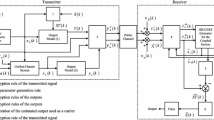Abstract
The use of chaotic codes in transmission systems presents many advantages, not only in term of security, but also to combat multi-path propagations and to allow multiple access. Nevertheless, the main problem of communication with chaos is the design of an experimental and real-time synchronization decoder between transmitter and receiver. In this paper, we suggest to use the belief propagation algorithm as a new approach for synchronizing quasi-chaotic signals. In this approach, the transmitter contains a digital chaotic oscillator which is perturbed by the information signal. The receiver consists in a dual system augmented with a belief propagation processing, whose aim is to recover the information signal. We suppose that the channel is Gaussian and synchronization is forced in a first step. Once synchronization is achieved, the information signal modulated the chaotic system and is transmitted on the Gaussian channel. An adaptative belief propagation algorithm is processed to recover the signal information.







Similar content being viewed by others
References
Kolumban G, Vizvari B, Schwarz W, Abel A (1996) Differential chaos shift keying: A robust coding for chaos communication, in PROC. IEEE Workshop on Nonlinear Dynam Electon Syst 87–92.
Cong L, Xiaofu W (2001) Design and realization of an FPGA-based generator for chaotic frequency hopping sequences. IEEE Transactions on circuits and systems-I Fundamental theory and applications 48:521–532
Dedieu H, Schweizer J Chaos communication from a maximum likelihood perspective, in Proceedings of the 6th Int. Workshop on Nonlinear Dynamics of Electronic Systems, 53–62, NDES’98.
Cuomo KM, Oppenheim AV (1993) Circuit implementation of synchronized chaos with applications to communications. Phys Rev Lett 71(1):65–68
Kaddoum G, Anthony J, Lawrance P, Chargé D, Roviras (2011) Chaos communication performance. Theory and Computation, Circuits, Systems, and Signal Processing 30(1):185–208
Kocarev LJ, Halle KS, Eckert K, Chua LO, Parlitz U (1992) Experimental demonstration of secure communications via chaotic synchronization. Int J Bifurcation Chaos 2(3):709–713
Mamat M, Salleh Z, Sanjaya M, Noor M, Ahmad F (2012) Numerical simulation of unidirectional chaotic synchronization of non-autonomous circuit and its application for secure communication. Adv Studies Theor Phys 6(10):497–509
Pecora LM, Carroll TL (1992) Synchronization in chaotic systems. Phys Rev Lett 64:973–977
Lee TH, Park JH (2012) Generalized functional projective synchronization of Chen–Lee chaotic systems and its circuit implementation. International Journal of the Physical Sciences 5(7):1183–1190
Mangeot J, Launay F, Coirault P (2006) Masked symmetric chaos shift keying : modulation and demodulation of Chua's circuits using PI control estimated from LMI criterion. IEEE Industrial Electronics, IECON 2006 - 32nd Annual Conference, 6–10
Mangeot J, Launay F, Coirault P (2008) A multi-user transmission using chaotic carriers, Commun Nonlinear Sci Numer Simulat
Berrou C, Glavieux A, Thitimajshima P (1993) Near Shannon limit error-correcting coding and decoding : Turbo codes, International Communications Conference (ICC), 1064–1070, Geneva, Switzerland
Forney DG (March) The Viterbi algorithm. Proceedings of the IEEE 269–278:61(3)
Baum LE, Petrie T (1966) Statistical inference for probabilistic functions of finite state Markov chains. Ann Math Stat 37:1559–1563
Rabiner LR (1989) A tutorial on hidden markov models and selected applications in speech recognition, Proceeding of the IEEE, vol 77,n2
Douc R, Matias C (2001) Asymptotics of the Maximum likelihood estimator for general Hidden Markov Models. Bernoulli 7:381–420
Luengo D, Santamarıa I, Vielva L (2005) Asymptotically optimal maximum-likehood estimation of a class of chaotic signals using the Viterbi algorithm. Proc XIII European Signal Processing Conf (EUSIPCO), Antalya (Turkey), 4–8
Ciftci M (2001) Optimal estimation and sequential channel equalization algorithms for chaotic communications systems. EURASIP Journal on Applied Signal Processing 4:249–256
Frey DR (1993) Chaotic digital encoding : An approach to secure communication. IEEE TRans Circuit & Systs II :Analog and Digital Signal Processing 40:660–666
Mazzini G, Sett G, Rovatti R (1997) Chaotic complex spreading sequences for asynchronous ds-cdma-part i: system modelling and results. IEEE Trans Circuits Systems-I: Fundam Theory Appl 10:937–947
Author information
Authors and Affiliations
Corresponding author
Rights and permissions
About this article
Cite this article
Launay, F., Coirault, P. A second-order Markov model to synchronize a quasi-chaotic sequence: application of synchronization and decoding problem with belief propagation. Ann. Telecommun. 69, 147–154 (2014). https://doi.org/10.1007/s12243-013-0406-3
Received:
Accepted:
Published:
Issue Date:
DOI: https://doi.org/10.1007/s12243-013-0406-3




